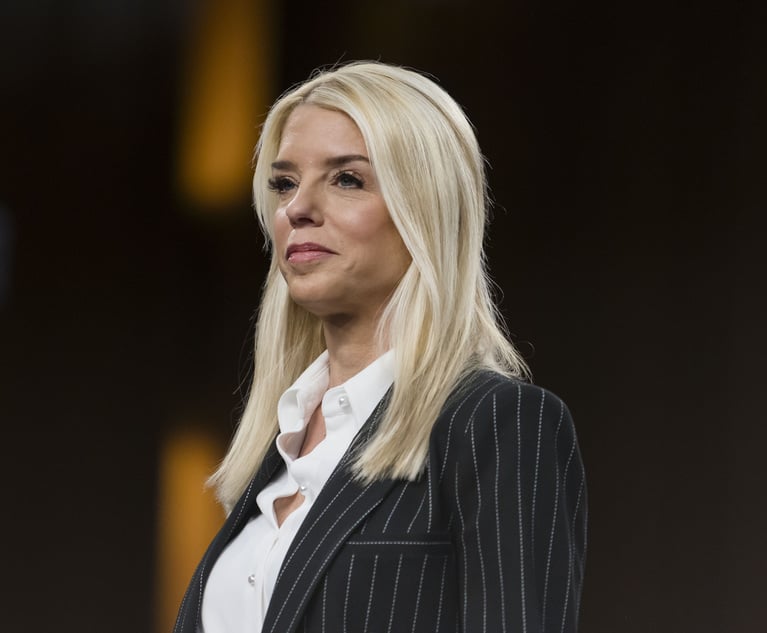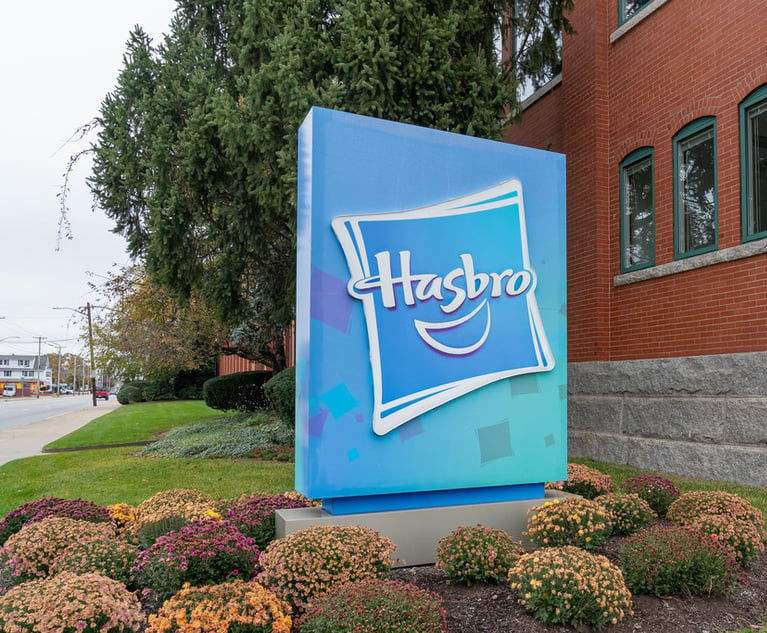NY Opioid Litigation on Fast Track as Judge Rules Counties May Press Claims Against Distributors
A New York judge presiding over the state courts' multicounty opioid litigation in Suffolk County brought on behalf of a coalition of New York counties, which is being closely watched by courts in other jurisdictions around the country, has refused to toss claims against drug distributors.
July 17, 2018 at 06:51 PM
4 minute read
 Bottles of Purdue Pharma OxyContin, an opioid medication. Photo: George Frey/Bloomberg LP A New York judge presiding over the state courts' multicounty opioid litigation in Suffolk County brought on behalf of a coalition of New York counties, which is being closely watched by courts in other jurisdictions around the country, has refused to toss claims against drug distributors. The ruling, by Suffolk County Supreme Court Justice Jerry Garguilo, to deny motions to dismiss by pharmaceutical drug distributors named as defendants in the case comes one month after he refused to dismiss suits against a group of drug manufacturers. The rulings were the “first of their kind” in the United States, said plaintiffs attorney Paul Napoli. He said the decisions place the New York litigation, brought on behalf of some 50 counties, at the head of the pack compared with the federal multidistrict litigation that's playing out in Ohio and cases proceeding in courts in Pennsylvania, Tennessee and West Virginia. “This is another major victory for New York in both this litigation and in its battle against the opioid epidemic,” Napoli said in a written statement. “The distributor defendants were entrusted to act as intermediaries between manufacturers and pharmacies, but instead they were integral to the scheme to expand the market for prescription opioids.” Garguilo said that counties may proceed with claims that a group of distributors that includes McKesson Corp., Cardinal Health, Kinray and AmerisourceBergen Drug Corp., violated New York's consumer fraud and false advertising laws. The counties are also moving forward with public nuisance, negligence, unjust enrichment and fraud claims against the defendants. “The plaintiffs allege that the defendants, acting in concert employed assiduously crafted, multipronged marketing strategies that targeted the general public through websites, print advertisements, and educational materials and publications as part of their scheme to change the perception of the risks associated with prescription opioids and to destigmatize and normalize the long-term use of opioids for chronic nonmalignant pain,” the judge said. In June, Garguilo denied motions by Purdue Pharma, Endo Health Solutions, Teva Pharmaceuticals, Allergan, Johnson & Johnson's Janssen Pharmaceuticals Inc. and Insys Therapeutics Inc. to dismiss similar claims. A spokeswoman for McKesson declined to comment, citing pending litigation, while spokespersons for the remaining distributor defendants did not respond to requests for comment. The New York counties allege that opioid manufacturers and distributors, as well as individual physicians named in the case, worked together a scheme to promote the use of opioids to treat chronic pain by using deceptive marketing techniques on the public and the medical community, which gave rise to the opioid epidemic that is ravaging communities across the country. The distributors' role in the scheme, the counties allege, was taking part in an “unbranded marketing campaign” in which the distributors provided funding to front groups such as the American Pain Foundation and the American Academy of Pain Medicine and “key opinion leaders” who disseminated deceptive messages about the dangers and benefits of prescription opioid use. The counties also said the distributors worked as intermediaries between manufacturers and pharmacies, and were “integral” to the scheme by shipping suspicious orders and not taking steps to ensure that the counties were not being oversaturated with opioids. In effect, the New York counties say they've been stuck with the bills for prescription costs for employees that may not have been paid out had the risks of opioids like OxyContin been widely known, as well as the costs of dealing with the fallout of the epidemic, like combating criminal activity associated with the opioid trade and distributing naloxone to first responders for trying to bring overdosing opioid users back from the brink. Motions by distributors and manufacturers to dismiss the federal multidistrict litigation in Ohio district court are pending. As for the New York case, Napoli said the plaintiffs hope to bring the case to trial by spring 2019 and will suggest that he choose four counties—two upstate, two downstate—to serve as bellwethers for the full group of plaintiffs.
Bottles of Purdue Pharma OxyContin, an opioid medication. Photo: George Frey/Bloomberg LP A New York judge presiding over the state courts' multicounty opioid litigation in Suffolk County brought on behalf of a coalition of New York counties, which is being closely watched by courts in other jurisdictions around the country, has refused to toss claims against drug distributors. The ruling, by Suffolk County Supreme Court Justice Jerry Garguilo, to deny motions to dismiss by pharmaceutical drug distributors named as defendants in the case comes one month after he refused to dismiss suits against a group of drug manufacturers. The rulings were the “first of their kind” in the United States, said plaintiffs attorney Paul Napoli. He said the decisions place the New York litigation, brought on behalf of some 50 counties, at the head of the pack compared with the federal multidistrict litigation that's playing out in Ohio and cases proceeding in courts in Pennsylvania, Tennessee and West Virginia. “This is another major victory for New York in both this litigation and in its battle against the opioid epidemic,” Napoli said in a written statement. “The distributor defendants were entrusted to act as intermediaries between manufacturers and pharmacies, but instead they were integral to the scheme to expand the market for prescription opioids.” Garguilo said that counties may proceed with claims that a group of distributors that includes McKesson Corp., Cardinal Health, Kinray and AmerisourceBergen Drug Corp., violated New York's consumer fraud and false advertising laws. The counties are also moving forward with public nuisance, negligence, unjust enrichment and fraud claims against the defendants. “The plaintiffs allege that the defendants, acting in concert employed assiduously crafted, multipronged marketing strategies that targeted the general public through websites, print advertisements, and educational materials and publications as part of their scheme to change the perception of the risks associated with prescription opioids and to destigmatize and normalize the long-term use of opioids for chronic nonmalignant pain,” the judge said. In June, Garguilo denied motions by Purdue Pharma, Endo Health Solutions, Teva Pharmaceuticals, Allergan, Johnson & Johnson's Janssen Pharmaceuticals Inc. and Insys Therapeutics Inc. to dismiss similar claims. A spokeswoman for McKesson declined to comment, citing pending litigation, while spokespersons for the remaining distributor defendants did not respond to requests for comment. The New York counties allege that opioid manufacturers and distributors, as well as individual physicians named in the case, worked together a scheme to promote the use of opioids to treat chronic pain by using deceptive marketing techniques on the public and the medical community, which gave rise to the opioid epidemic that is ravaging communities across the country. The distributors' role in the scheme, the counties allege, was taking part in an “unbranded marketing campaign” in which the distributors provided funding to front groups such as the American Pain Foundation and the American Academy of Pain Medicine and “key opinion leaders” who disseminated deceptive messages about the dangers and benefits of prescription opioid use. The counties also said the distributors worked as intermediaries between manufacturers and pharmacies, and were “integral” to the scheme by shipping suspicious orders and not taking steps to ensure that the counties were not being oversaturated with opioids. In effect, the New York counties say they've been stuck with the bills for prescription costs for employees that may not have been paid out had the risks of opioids like OxyContin been widely known, as well as the costs of dealing with the fallout of the epidemic, like combating criminal activity associated with the opioid trade and distributing naloxone to first responders for trying to bring overdosing opioid users back from the brink. Motions by distributors and manufacturers to dismiss the federal multidistrict litigation in Ohio district court are pending. As for the New York case, Napoli said the plaintiffs hope to bring the case to trial by spring 2019 and will suggest that he choose four counties—two upstate, two downstate—to serve as bellwethers for the full group of plaintiffs.This content has been archived. It is available through our partners, LexisNexis® and Bloomberg Law.
To view this content, please continue to their sites.
Not a Lexis Subscriber?
Subscribe Now
Not a Bloomberg Law Subscriber?
Subscribe Now
NOT FOR REPRINT
© 2025 ALM Global, LLC, All Rights Reserved. Request academic re-use from www.copyright.com. All other uses, submit a request to [email protected]. For more information visit Asset & Logo Licensing.
You Might Like
View All
Justice 'Weaponization Working Group' Will Examine Officials Who Investigated Trump, US AG Bondi Says

Lawyers Across Political Spectrum Launch Public Interest Team to Litigate Against Antisemitism
4 minute read
'Landmark' New York Commission Set to Study Overburdened, Under-Resourced Family Courts

Trending Stories
- 1States Accuse Trump of Thwarting Court's Funding Restoration Order
- 2Microsoft Becomes Latest Tech Company to Face Claims of Stealing Marketing Commissions From Influencers
- 3Coral Gables Attorney Busted for Stalking Lawyer
- 4Trump's DOJ Delays Releasing Jan. 6 FBI Agents List Under Consent Order
- 5Securities Report Says That 2024 Settlements Passed a Total of $5.2B
Who Got The Work
J. Brugh Lower of Gibbons has entered an appearance for industrial equipment supplier Devco Corporation in a pending trademark infringement lawsuit. The suit, accusing the defendant of selling knock-off Graco products, was filed Dec. 18 in New Jersey District Court by Rivkin Radler on behalf of Graco Inc. and Graco Minnesota. The case, assigned to U.S. District Judge Zahid N. Quraishi, is 3:24-cv-11294, Graco Inc. et al v. Devco Corporation.
Who Got The Work
Rebecca Maller-Stein and Kent A. Yalowitz of Arnold & Porter Kaye Scholer have entered their appearances for Hanaco Venture Capital and its executives, Lior Prosor and David Frankel, in a pending securities lawsuit. The action, filed on Dec. 24 in New York Southern District Court by Zell, Aron & Co. on behalf of Goldeneye Advisors, accuses the defendants of negligently and fraudulently managing the plaintiff's $1 million investment. The case, assigned to U.S. District Judge Vernon S. Broderick, is 1:24-cv-09918, Goldeneye Advisors, LLC v. Hanaco Venture Capital, Ltd. et al.
Who Got The Work
Attorneys from A&O Shearman has stepped in as defense counsel for Toronto-Dominion Bank and other defendants in a pending securities class action. The suit, filed Dec. 11 in New York Southern District Court by Bleichmar Fonti & Auld, accuses the defendants of concealing the bank's 'pervasive' deficiencies in regards to its compliance with the Bank Secrecy Act and the quality of its anti-money laundering controls. The case, assigned to U.S. District Judge Arun Subramanian, is 1:24-cv-09445, Gonzalez v. The Toronto-Dominion Bank et al.
Who Got The Work
Crown Castle International, a Pennsylvania company providing shared communications infrastructure, has turned to Luke D. Wolf of Gordon Rees Scully Mansukhani to fend off a pending breach-of-contract lawsuit. The court action, filed Nov. 25 in Michigan Eastern District Court by Hooper Hathaway PC on behalf of The Town Residences LLC, accuses Crown Castle of failing to transfer approximately $30,000 in utility payments from T-Mobile in breach of a roof-top lease and assignment agreement. The case, assigned to U.S. District Judge Susan K. Declercq, is 2:24-cv-13131, The Town Residences LLC v. T-Mobile US, Inc. et al.
Who Got The Work
Wilfred P. Coronato and Daniel M. Schwartz of McCarter & English have stepped in as defense counsel to Electrolux Home Products Inc. in a pending product liability lawsuit. The court action, filed Nov. 26 in New York Eastern District Court by Poulos Lopiccolo PC and Nagel Rice LLP on behalf of David Stern, alleges that the defendant's refrigerators’ drawers and shelving repeatedly break and fall apart within months after purchase. The case, assigned to U.S. District Judge Joan M. Azrack, is 2:24-cv-08204, Stern v. Electrolux Home Products, Inc.
Featured Firms
Law Offices of Gary Martin Hays & Associates, P.C.
(470) 294-1674
Law Offices of Mark E. Salomone
(857) 444-6468
Smith & Hassler
(713) 739-1250






